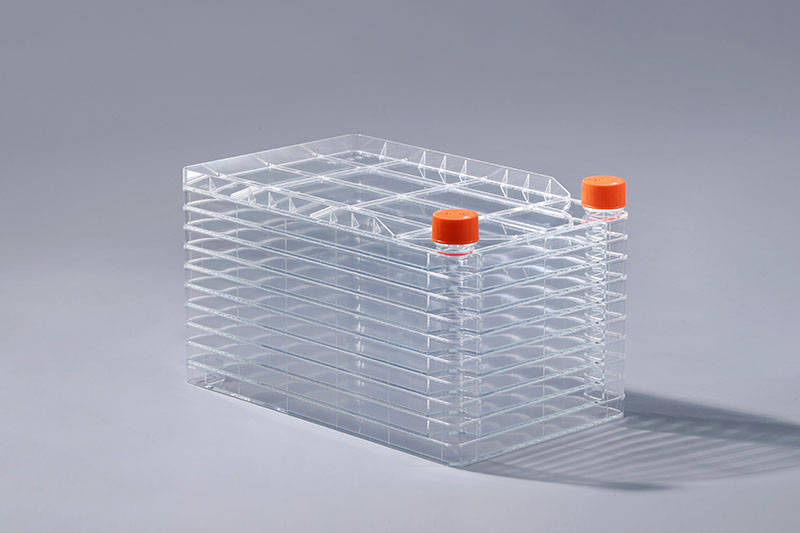เป็นวัสดุสิ้นเปลืองสำหรับการเพาะเลี้ยงเซลล์แบบหลายชั้น ซึ่งส่วนใหญ่ใช้ในการผลิตจำนวนมากทางอุตสาหกรรม การปฏิบัติงานในห้องปฏิบัติการ และการเพาะเลี้ยงเซลล์ขนาดใหญ่ และเป็นตัวเลือกในอุดมคติสำหรับเซลล์ที่ยึดติด ในการเลือกวัสดุสิ้นเปลืองประเภทนี้ เราจะใส่ใจกับปัจจัยสำคัญ นั่นคือ การรักษาพื้นผิว TC แล้วทำไมจึงต้องเข้ารับการบำบัดพิเศษนี้ด้วย?Cells แบ่งได้เป็น 2 ประเภท คือ สมัครพรรคพวก เซลล์และเซลล์แขวนลอยตามวิธีการเจริญเติบโตที่แตกต่างกัน ไม่จำเป็นต้องติดเซลล์แขวนลอยกับตัวรองรับเพื่อให้เจริญเติบโต และสามารถเติบโตในสารแขวนลอยในอาหารเลี้ยงเชื้อ เซลล์ที่เกาะติดกันต้องมีพื้นผิวที่เติบโตซึ่งสามารถเกาะติดเพื่อเติบโตได้ และมีเพียงส่วนต่อประสานที่เป็นของแข็งที่ชอบน้ำเท่านั้นจึงจะยอมให้เซลล์ยึดติดได้cell factory
โรงงานเซลล์ส่วนใหญ่จะใช้สำหรับการเพาะเลี้ยงเซลล์เกาะติดซึ่งผ่านกรรมวิธีโดยการฉีดขึ้นรูปของ วัตถุดิบโพลีสไตรีนโปร่งใส (PS) เนื่องจากเป็นวัสดุโพลีเมอร์ PS มีความแข็งแรงและยืดหยุ่นได้ดี และไม่มีพิษ และกลายเป็นวัสดุที่นิยมใช้สำหรับการเพาะเลี้ยงเซลล์แบบใช้แล้วทิ้ง อย่างไรก็ตาม พื้นผิวของ PS เป็นแบบไม่ชอบน้ำ ซึ่งตัวมันเองไม่เอื้อต่อการเจริญเติบโตของเซลล์ที่ยึดเกาะ เพื่อเพิ่มประสิทธิภาพการเกาะติดของเซลล์ จำเป็นต้องรับการบำบัดด้วยการดัดแปลงพื้นผิวและแนะนำกลุ่มที่ชอบน้ำเพื่อให้เซลล์เจริญเติบโตได้ดีขึ้น
โดยสรุป วัตถุประสงค์ของการบำบัด TC บนพื้นผิวของโรงงานเซลล์คือการปรับให้เข้ากับ การเจริญเติบโตของเซลล์ยึดเกาะ วัสดุสิ้นเปลืองที่ใช้สำหรับการเพาะเลี้ยงเซลล์แขวนลอยไม่จำเป็นต้องมีภาชนะที่บำบัดพิเศษเช่นนั้น แต่วัสดุสิ้นเปลืองหลังการบำบัด TC ที่พื้นผิวโดยทั่วไปยังเหมาะสำหรับการเพาะเลี้ยงเซลล์แขวนลอย
In summary, the purpose of TC treatment on the cell factory surface is to adapt to the growth of adherent cells. The consumables used for suspension cell culture do not necessarily require such specially treated vessels, but the consumables after surface TC treatment are generally also suitable for the culture of suspension cells.
The FAI climbed 5.9 percent year-on-year in the first 11 months of 2018, quickening from the 5.7-percent growth in Jan-Oct, the National Bureau of Statistics (NBS) said Friday in an online statement.
The key indicator of investment, dubbed a major growth driver, hit the bottom in August and has since started to rebound steadily.
In the face of emerging economic challenges home and abroad, China has stepped up efforts to stabilize investment, in particular rolling out measures to motivate private investors and channel funds into infrastructure.
Friday's data showed private investment, accounting for more than 60 percent of the total FAI, expanded by a brisk 8.7 percent.
NBS spokesperson Mao Shengyong said funds into weak economic links registered rapid increases as investment in environmental protection and agriculture jumped 42 percent and 12.5 percent respectively, much faster than the average.
In breakdown, investment in high-tech and equipment manufacturing remained vigorous with 16.1-percent and 11.6-percent increases respectively in the first 11 months. Infrastructure investment gained 3.7 percent, staying flat. Investment in property development rose 9.7 percent, also unchanged.
 English
English



















































